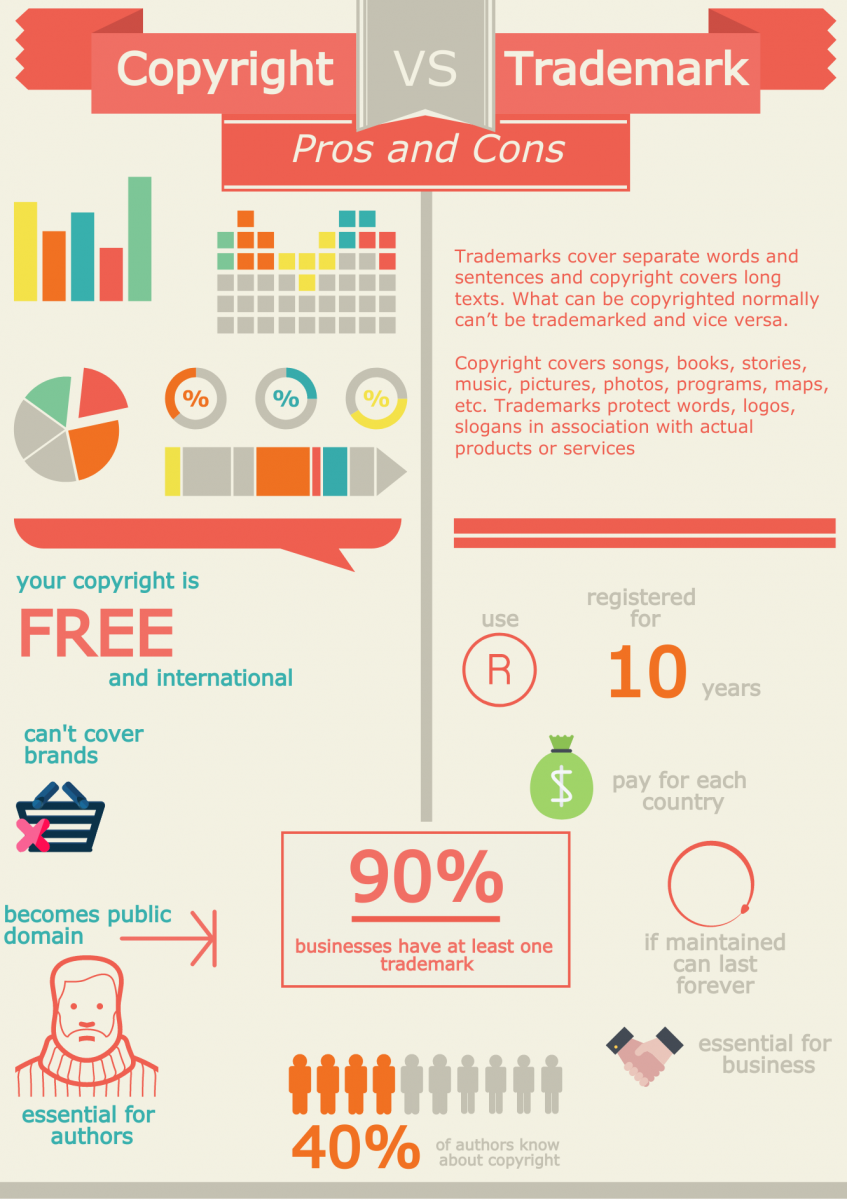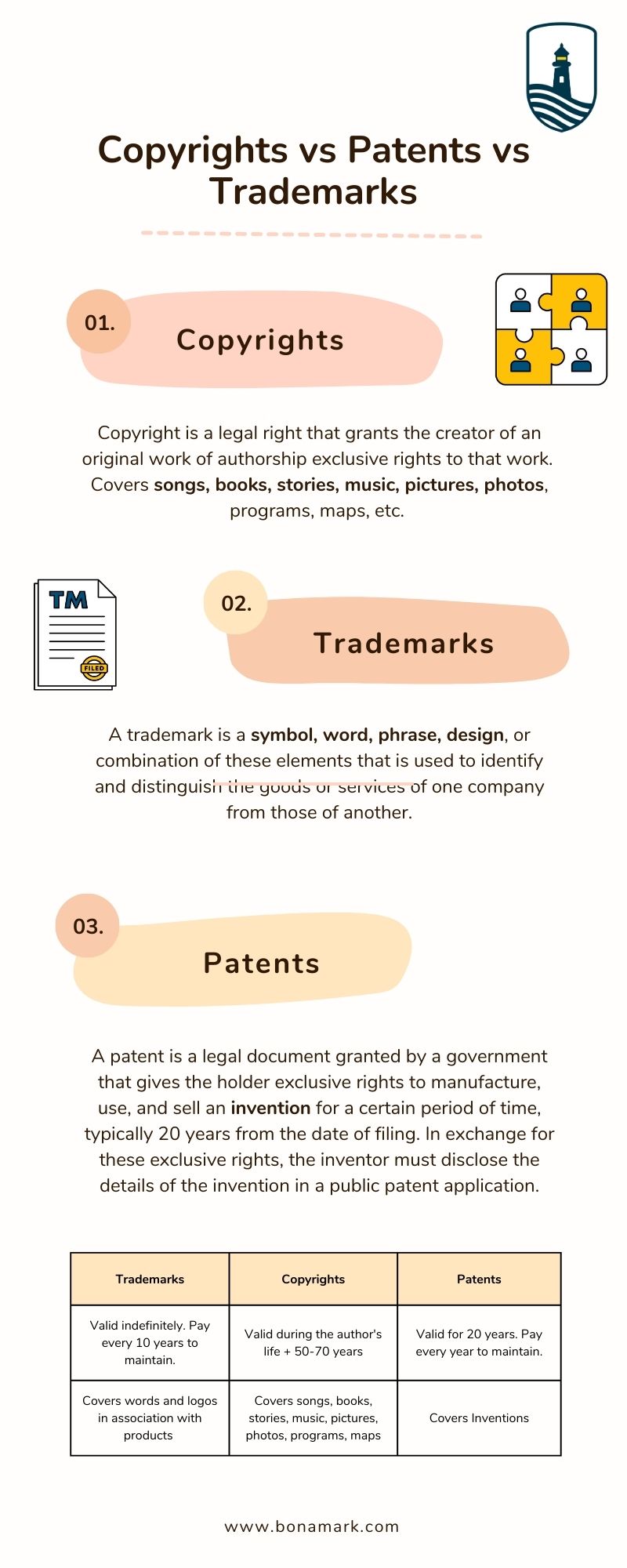Copyright vs Trademark vs Patent: What's the Difference? Pros & Cons?
Difference between a copyright and a trademark
The difference is fairly simple when we talk about words. Trademarks cover separate words and sentences and copyright covers long texts. What can be copyrighted normally can’t be trademarked and vice versa. But this applies only to the word parts, when we come to protecting logos, everything is quite different.
A logo can be protected by copyright and trademark at the same time!
How to avoid the confusion and get an optimal protection for your trademark/logo?
Keep on reading!
What are the main differences between copyright and trademark?

|
TRADEMARKS Used to cover names of products/services |
COPYRIGHT Used to cover literary and artistic works |
|
|
UPSIDE |
|
|
|
DOWNSIDE |
|
|
What does copyright cover?
Copyright is a legal right that grants the creator of an original work of authorship exclusive rights to that work.
Many different things: songs, books, stories, music, pictures, photos, programs, maps, etc. The creation must be sufficiently big (you can’t cover a few words by copyright) and be sufficiently distinctive.
Copyright does not cover separate words, titles, slogans, and some logos.
What rights will I get if my creation is copyrighted?
You will have 2 types of rights:
- economic rights, which allow you to get money if someone is using your copyright;
- moral rights, your right to be named the author of the creation, for example.
You and only you can allow others to reproduce, record, broadcast and translate your creation.
What trademarks are for?
When you plan to use your brand in commerce, in association with actual products or services, the brand needs protection. This protection is obtained by filing a trademark.
This is not free, but this is the only way. A trademark can be a word, title, slogan, or logo. Trademark can’t protect long portions of texts and usually do not protect songs, music, and photos.
What rights a trademark will give me?
So, let's dive deeper into the comparison copyright vs trademark. The main right is to use the trademarked word or logo exclusively in association with the products or service you want to cover. That’s right, others can’t produce similar goods with a similar name.
Let that sink in for a moment.
There is a simple test to determine if you need a trademark or copyright. When you plan to sell your products or services, you should get a trademark. Plan to write a new book? You will need a copyright.
Trademarks are always registered in association with some product or service. They can’t exist without it, they must cover some specific group of goods. There can be a trademark for water, for cars, for banks, but there can’t be a trademark on its own.
So when you plan to sell a particular product - get a trademark.
That’s a tricky question. In some cases, you will need a trademark AND copyright. You don’t need the mark to cover the name of the book as such, but you might need it if you decide to sell branded products. For example, HARRY POTTER is trademarked and all the books are copyrighted. Star Wars is a trademark and all the films are copyrighted.
But these brands are protected in association with some particular services and products. They are registered for T-shirts, toys, theme parks, apparel, food, etc. They do not exist on their own.
The crucial difference between copyright and trademark
What's a Patent?
A patent is a legal document granted by a government that gives the holder exclusive rights to manufacture, use, and sell an invention for a certain period of time, typically 20 years from the date of filing. In exchange for these exclusive rights, the inventor must disclose the details of the invention in a public patent application.
Patents are granted to protect and incentivize innovation by giving inventors a monopoly over their inventions for a limited period of time. This allows inventors to recoup the costs of research and development and to profit from their inventions. In return, the public benefits from the disclosure of the invention, which can lead to further innovation and improvements.
Patents are granted for a wide range of inventions, including machines, processes, products, and compositions of matter. In order to be granted a patent, the invention must meet certain criteria, including novelty, non-obviousness, and usefulness.
Patent protection is granted on a country-by-country basis, meaning that a patent granted in one country does not necessarily offer protection in other countries.

Copyright vs Patent
Copyright and patent are both forms of intellectual property protection, but they protect different types of creations and provide different types of rights.
Copyright is a legal right that protects the original expression of an idea in a tangible form, such as a book, a song, or a computer program. Copyright provides the owner with the exclusive right to control the reproduction, distribution, and public performance of the work. Copyright protection is automatic and lasts for a fixed term, generally the lifetime of the creator plus a certain number of years.
Patent, on the other hand, is a legal right that protects new and useful inventions, such as machines, processes, and compositions of matter. Patents give the owner the exclusive right to make, use, and sell the invention for a certain period of time, typically 20 years from the date of filing. In exchange for this exclusive right, the patent holder must publicly disclose the details of the invention. Unlike copyright, obtaining a patent requires a formal application process and examination by a government agency, and the invention must meet certain criteria, such as novelty, non-obviousness, and usefulness.
In general, copyright protects the expression of an idea, while patent protects the idea itself in the form of an invention. While both copyright and patent provide a level of protection for intellectual property, they apply to different types of creations and offer different types of legal protection.
Copyright vs. trademark vs. patent examples
Copyright Example: the entire book of Harry Potter and the Philosopher's Stone.
Trademark Example: Harry Potter and the Philosopher's Stone® for movies and merchandise. The mark is registered in the USA, for example. Such a mark has a registration number and an expiration date.
Patent Example: there is no good example in relation to Harry Potter. I'll give another example: a pharmaceutical company that develops a new drug may be granted a patent on the drug, which gives them the exclusive right to manufacture and sell the drug for a period of time.
Conclusion
In conclusion, trademarks, patents and copyrights are important forms of intellectual property protection that can help authors,inventors and creators establish and protect their brand identity, inventions and original works.
If you are an author or creator, it is essential to understand the importance of these legal protections and take the necessary steps to safeguard your intellectual property.
One way to do this is by contacting Bonamark.com, a leading trademark registration and intellectual property protection company. Our team of experts can provide you with comprehensive services to help you register your trademark, protect your copyrights, and safeguard your intellectual property rights.
By working with Bonamark.com, you can have peace of mind knowing that your intellectual property is protected and that you can focus on what you do best - creating and innovating. So, don't hesitate - contact Bonamark.com today to protect your intellectual property and secure your rights.